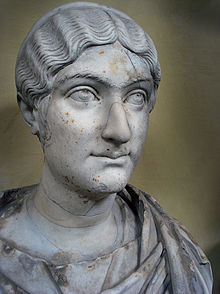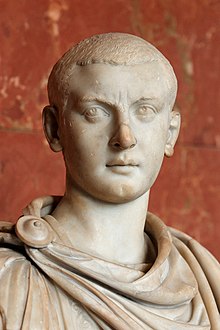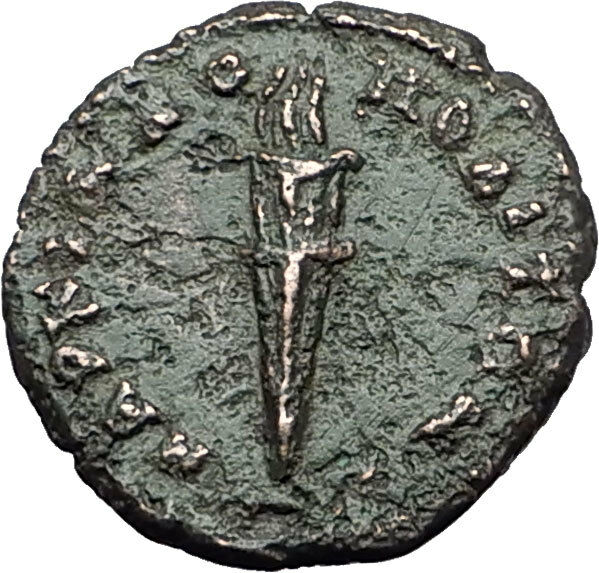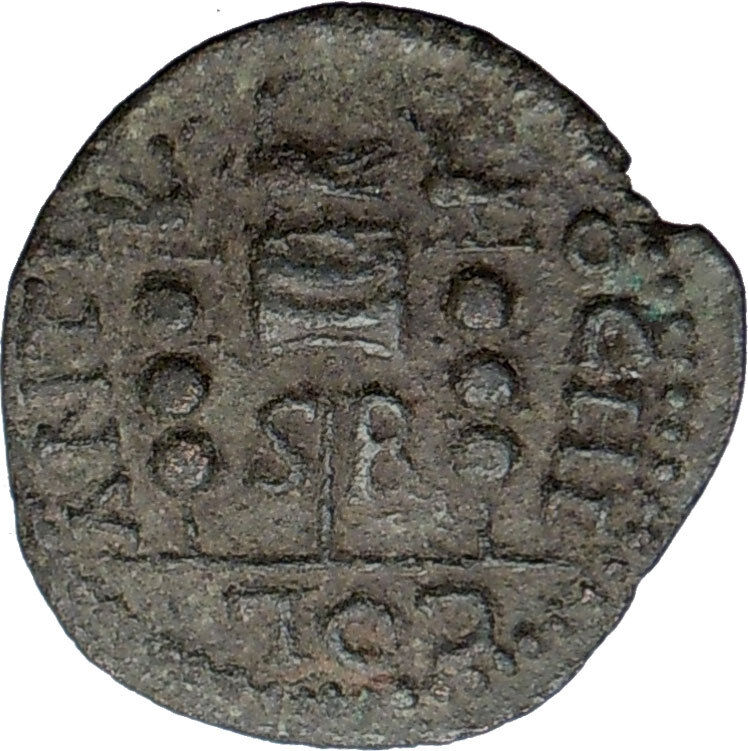|
Gordian III – Roman Emperor: 238-244 A.D.
GORDIAN III & TRANQUILLINA
Bronze 25mm (7.68 grams) of Mesembria in Thrace
AVT K M ANT ΓOPΔIANOC AVΓ CEB TPAHKVΛΛΙΝA, confronted busts of Gordian III & Tranquillina facing each other.
MECAMBPIANΩN, Tyche standing left holding patera and cornucopia.
You are bidding on the exact item pictured, provided with a Certificate of Authenticity and Lifetime Guarantee of Authenticity.
 Tyche (meaning “luck”; Roman equivalent: Fortuna) was the presiding tutelary deity that governed the fortune and prosperity of a city, its destiny. She is the daughter of Aphrodite and Zeus or Hermes. Tyche (meaning “luck”; Roman equivalent: Fortuna) was the presiding tutelary deity that governed the fortune and prosperity of a city, its destiny. She is the daughter of Aphrodite and Zeus or Hermes.
In literature, she might be given various genealogies, as a daughter of Hermes and Aphrodite, or considered as one of the Oceanids, daughters of Oceanus and Tethys, or of Zeus. She was connected with Nemesis and Agathos Daimon (“good spirit”).
The Greek historian Polybius believed that when no cause can be discovered to events such as floods, droughts, frosts or even in politics, then the cause of these events may be fairly attributed to Tyche.
Worship
Increasingly during the Hellenistic period, cities venerated their own specific iconic version of Tyche, wearing a mural crown (a crown like the walls of the city).
Tyche had temples at Caesarea Maritima, Antioch, Alexandria and Constantinople. In Alexandria the Tychaeon, the temple of Tyche, was described by Libanius as one of the most magnificent of the entire Hellenistic world.
She was uniquely venerated at Itanos in Crete, as Tyche Protogeneia, linked with the Athenian Protogeneia (“firstborn”), daughter of Erechtheus, whose self-sacrifice saved the city.
Stylianos Spyridakis concisely expressed Tyche’s appeal in a Hellenistic world of arbitrary violence and unmeaning reverses: “In the turbulent years of the Epigoni of Alexander, an awareness of the instability of human affairs led people to believe that Tyche, the blind mistress of Fortune, governed mankind with an inconstancy which explained the vicissitudes of the time.”
Depictions
Tyche appears on many coins of the Hellenistic period in the three centuries before the Christian era, especially from cities in the Aegean. Unpredictable turns of fortune drive the complicated plotlines of Hellenistic romances, such as Leucippe and Clitophon or Daphnis and Chloe. She experienced a resurgence in another era of uneasy change, the final days of publicly sanctioned Paganism, between the late-fourth-century emperors Julian and Theodosius I who definitively closed the temples. The effectiveness of her capricious power even achieved respectability in philosophical circles during that generation, though among poets it was a commonplace to revile her for a fickle harlot.
In medieval art, she was depicted as carrying a cornucopia, an emblematic ship’s rudder, and the wheel of fortune, or she may stand on the wheel, presiding over the entire circle of fate.
The constellation of Virgo is sometimes identified as the heavenly figure of Tyche, as well as other goddesses such as Demeter and Astraea.
 Nesebar (Thracian: Menebria; Greek: Μεσήμβρια, Mesimvria, previously known as Mesembria; other spellings include Nessebar and Nesebur) is an ancient city and a major seaside resort on the Black Sea coast of Bulgaria, located in Nesebar municipality, Burgas Province. Often referred to as the “Pearl of the Black Sea” and “Bulgaria’s Dubrovnik“, Nesebar is a rich city-museum defined by more than three millennia of ever-changing history. Nesebar (Thracian: Menebria; Greek: Μεσήμβρια, Mesimvria, previously known as Mesembria; other spellings include Nessebar and Nesebur) is an ancient city and a major seaside resort on the Black Sea coast of Bulgaria, located in Nesebar municipality, Burgas Province. Often referred to as the “Pearl of the Black Sea” and “Bulgaria’s Dubrovnik“, Nesebar is a rich city-museum defined by more than three millennia of ever-changing history.
It is a one of the most prominent tourist destinations and seaports on the Black Sea, in what has become a popular area with several large resorts-the largest, Sunny Beach, is situated immediately to the north of Nesebar.
Nesebar has on several occasions found itself on the frontier of a threatened empire, and as such it is a town with a rich history. The ancient part of the town is situated on a peninsula (previously an island) connected to the mainland by a narrow man-made isthmus, and it bears evidence of occupation by a variety of different civilisations over the course of its existence. Its abundance of historic buildings prompted UNESCO to include Nesebar in its list of World Heritage Sites in 1983.
Originally a Thracian settlement known as Menebria, the town became a Greek colony when settled by Dorians from Megara at the beginning of the 6th century BC, and was an important trading centre from then on and a rival of Apollonia (Sozopol). It remained the only Doric colony along the Black Sea coast, as the rest were typical Ionic colonies. Remains from the Hellenistic period include the acropolis, a temple of Apollo, and an agora. A wall which formed part of the fortifications can still be seen on the north side of the peninsula. Bronze and silver coins were minted in the city since the 5th century BC and gold coins since the 3rd century BC.
The town fell under Roman rule in 71 BC, yet continued to enjoy privileges such as the right to mint its own coinage. It was one of the most important strongholds of the Byzantine Empire from the 5th century AD onwards, and was fought over by Byzantines and Bulgarians, being captured and incorporated in the lands of the First Bulgarian Empire in 812 by Khan Krum after a two week siege only to be ceded back to Byzantium by Knyaz Boris I in 864 and reconquered by his son Tsar Simeon the Great. During the time of the Second Bulgarian Empire it was also contested by Bulgarian and Byzantine forces and enjoyed particular prosperity under Bulgarian tsar Ivan Alexander (1331-1371) until it was conquered by Crusaders led by Amadeus VI, Count of Savoy in 1366. The Slavic version of the name, Nesebar or Mesebar, has been attested since the 11th century.
Monuments from the Middle Ages include the 5-6th century Stara Mitropoliya (“old bishopric”; also St Sophia), a basilica without a transept; the 10th century church of the Virgin; and the 11th century Nova Mitropoliya (“new bishopric”; also St Stephen) which continued to be embellished until the 18th century. In the 13th and 14th century a remarkable series of churches were built: St Theodore, St Paraskeva, St Michael St Gabriel, and St John Aliturgetos.
The capture of the town by the Turks in 1453 marked the start of its decline, but its architectural heritage remained and was enriched in the 19th century by the construction of wooden houses in style typical for the Bulgarian Black Sea Coast during this period. It was a kaza centre in İslimye sanjak of Edirne Province before 1878. After the Liberation of Bulgaria from Ottoman rule in 1878, Nesebar became part of the autonomous Ottoman province of Eastern Rumelia as a kaza centre in Burgaz sanjak until it united with the Principality of Bulgaria in 1886.
Around the end of the 19th century Nesebar was a small town of Greek fishermen and vinegrowers, but developed as a key Bulgarian seaside resort since the beginning of the 20th century. After 1925 a new town part was built and the historic Old Town was restored.
Furia Sabinia Tranquillina or Sabinia Tranquillina (ca 225 – aft. 244) was the Empress of Rome and wife of Emperor Gordian III. She was the young daughter of the Praetorian Prefect Timesitheus by an unknown wife.
 In 241 her father was appointed the head of the Praetorian Guard by the Roman Emperor Gordian III. In May that year, Tranquillina had married Gordian. She became a Roman Empress and received the honorific title of Augusta. Her marriage to Gordian was an admission by the young emperor of both political indispensability of Timesitheus and Tranquillina’s suitability as an empress. In 241 her father was appointed the head of the Praetorian Guard by the Roman Emperor Gordian III. In May that year, Tranquillina had married Gordian. She became a Roman Empress and received the honorific title of Augusta. Her marriage to Gordian was an admission by the young emperor of both political indispensability of Timesitheus and Tranquillina’s suitability as an empress.
In 243, Tranquillina’s father suddenly died and was replaced with Philip the Arab, as head of the Praetorian Guard. When Gordian was killed in February 244, Philip became the new emperor. Tranquillina survived her husband. She had no sons with him. Christian Settipani suggests that they had a daughter, (Furia) (b. ca 244), most likely posthumous, who married (Marcus Maecius Orfitus) (b. ca 245), son of Marcus Maecius Probus (b. ca 220), married to Pupiena Sextia Paulina Cethegilla (b. ca 225), paternal grandson of Marcus Pomponius Maecius Probus and maternal grandson of Marcus Pupienus Africanus (son of his protector Emperor Pupienus Maximus) and wife Cornelia Marullina, by whom she had issue.
Gordian III – Roman Emperor: 238-244 A.D.
Caesar: 238 A.D. (under Balbinus and Pupienus)
Augustus: 238-244 A.D.
| Grandson of Gordian I | Nephew of Gordian II | Adopted Successor of Balbinus and Pupienus | Husband of Tranquillina |

Gordian III (Latin: Marcus Antonius Gordianus Pius Augustus; 20 January 225 AD – 11 February 244 AD) was Roman Emperor from 238 AD to 244 AD. At the age of 13, he became the youngest sole legal Roman emperor throughout the existence of the united Roman Empire. Gordian was the son of Antonia Gordiana and an unnamed Roman Senator who died before 238. Antonia Gordiana was the daughter of Emperor Gordian I and younger sister of Emperor Gordian II. Very little is known of his early life before his acclamation. Gordian had assumed the name of his maternal grandfather in 238 AD.
In 235, following the murder of Emperor Alexander Severus in Moguntiacum (modern Mainz), the capital of the Roman province Germania Superior, Maximinus Thrax was acclaimed Emperor. In the following years, there was a growing opposition against Maximinus in the Roman senate and amongst the majority of the population of Rome. In 238 a rebellion broke out in the Africa Province, where Gordian’s grandfather and uncle, Gordian I and II, were proclaimed joint emperors. This revolt was suppressed within a month by Cappellianus, governor of Numidia and a loyal supporter of Maximinus Thrax. The elder Gordians died, but public opinion cherished their memory as peace-loving and literate men, victims of Maximinus’ oppression.
Meanwhile, Maximinus was on the verge of marching on Rome and the Senate elected Pupienus and Balbinus as joint emperors. These senators were not popular men and the population of Rome was still shocked by the elder Gordian’s fate, so the Senate decided to take the teenager Gordian, rename him Marcus Antonius Gordianus like his grandfather, and raise him to the rank of Caesar and imperial heir. Pupienus and Balbinus defeated Maximinus, mainly due to the defection of several legions, particularly the II Parthica, who assassinated Maximinus. However, their joint reign was doomed from the start with popular riots, military discontent and an enormous fire that consumed Rome in June 238. On July 29, Pupienus and Balbinus were killed by the Praetorian Guard and Gordian proclaimed sole emperor.
Rule
Due to Gordian’s age, the imperial government was surrendered to the aristocratic families, who controlled the affairs of Rome through the Senate. In 240, Sabinianus revolted in the African province, but the situation was quickly brought under control. In 241, Gordian was married to Furia Sabinia Tranquillina, daughter of the newly appointed praetorian prefect, Timesitheus. As chief of the Praetorian Guard and father in law of the Emperor, Timesitheus quickly became the de facto ruler of the Roman Empire.
In the 3rd century, the Roman frontiers weakened against the Germanic tribes across the Rhine and Danube, and the Sassanid Empire across the Euphrates increased its own attacks. When the Persians under Shapur I invaded Mesopotamia, the young emperor opened the doors of the Temple of Janus for the last time in Roman history, and sent a large army to the East. The Sassanids were driven back over the Euphrates and defeated in the Battle of Resaena (243). The campaign was a success and Gordian, who had joined the army, was planning an invasion of the enemy’s territory, when his father-in-law died in unclear circumstances. Without Timesitheus, the campaign, and the Emperor’s security, were at risk.
Gaius Julius Priscus and, later on, his own brother Marcus Julius Philippus, also known as Philip the Arab, stepped in at this moment as the new Praetorian Prefects and the campaign proceeded. Around February 244, the Persians fought back fiercely to halt the Roman advance to Ctesiphon. Persian sources claim that a battle occurred (Battle of Misiche) near modern Fallujah (Iraq) and resulted in a major Roman defeat and the death of Gordian III. Roman sources do not mention this battle and suggest that Gordian died far away from Misiche, at Zaitha (Qalat es Salihiyah) in northern Mesopotamia. Modern scholarship does not unanimously accept this course of the events. One view holds that Gordian died at Zaitha, murdered by his frustrated army, while the role of Philip is unknown. Other scholars, such as Kettenhofen, Hartman and Winter have concluded that Gordian died in battle against the Sassanids.
Philip transferred the body of the deceased emperor to Rome and arranged for his deification. Gordian’s youth and good nature, along with the deaths of his grandfather and uncle and his own tragic fate at the hands of the enemy, earned him the lasting esteem of the Romans. The soldiers held Gordian in high esteem, as he had possibly sacrificed his life to save them in 244.
|





 Tyche (meaning “luck”; Roman equivalent: Fortuna) was the presiding tutelary deity that governed the fortune and prosperity of a city, its destiny. She is the daughter of Aphrodite and Zeus or Hermes.
Tyche (meaning “luck”; Roman equivalent: Fortuna) was the presiding tutelary deity that governed the fortune and prosperity of a city, its destiny. She is the daughter of Aphrodite and Zeus or Hermes. Nesebar (Thracian: Menebria; Greek: Μεσήμβρια, Mesimvria, previously known as Mesembria; other spellings include Nessebar and Nesebur) is an ancient city and a major seaside resort on the Black Sea coast of Bulgaria, located in Nesebar municipality, Burgas Province. Often referred to as the “Pearl of the Black Sea” and “Bulgaria’s Dubrovnik“, Nesebar is a rich city-museum defined by more than three millennia of ever-changing history.
Nesebar (Thracian: Menebria; Greek: Μεσήμβρια, Mesimvria, previously known as Mesembria; other spellings include Nessebar and Nesebur) is an ancient city and a major seaside resort on the Black Sea coast of Bulgaria, located in Nesebar municipality, Burgas Province. Often referred to as the “Pearl of the Black Sea” and “Bulgaria’s Dubrovnik“, Nesebar is a rich city-museum defined by more than three millennia of ever-changing history. In 241 her father was appointed the head of the Praetorian Guard by the Roman Emperor Gordian III. In May that year, Tranquillina had married Gordian. She became a Roman Empress and received the honorific title of Augusta. Her marriage to Gordian was an admission by the young emperor of both political indispensability of Timesitheus and Tranquillina’s suitability as an empress.
In 241 her father was appointed the head of the Praetorian Guard by the Roman Emperor Gordian III. In May that year, Tranquillina had married Gordian. She became a Roman Empress and received the honorific title of Augusta. Her marriage to Gordian was an admission by the young emperor of both political indispensability of Timesitheus and Tranquillina’s suitability as an empress.





